Teratogenic Drug
- directly or indirectly, causes a structural or functional change in the fetus or child if it is administrated to pregnant mother
- If mother is taking this drug, It can be either stopped, switched or reduced to the lowest dose possible
- Women to avoid all medications in the first 8 weeks after conception
Thalidomide: (Thalidomide disaster 1958-61)
- Hypnotic agent widely used in Europe in 1959
- An estimated 7000 infants born with thalidomide syndrome or phocomelia
- Characteristic features à include limb abnormalities
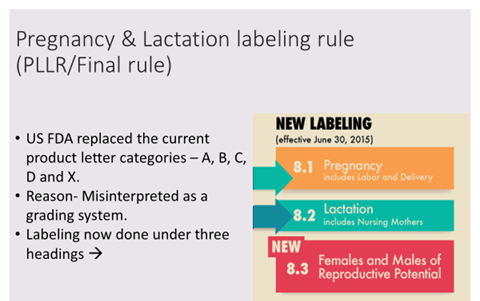
Previous classification
CATEGORY X
- demonstrates fetal abnormalities
- positive evidence of human fetal risk based on adverse reaction data
- the risks involved in use of the drug in pregnant women
POSSIBLE SITES OF ACTION OF TERATOGEN
DIRECT TOXIC ACTION
- FETUS:
-Direct toxicity.
-Metabolites toxic.
-Indirectly toxic, e.g. anti-metabolites, anti-vitamin.
-Pharmacodynamic actions, e.g. on cardiovascular system.
-Endocrine balance altered - FAETOPLACENTAL UNIT:
-Umbilical cord, e.g. spasm.
-Amniotic fluid volume change.
-Faetal or maternal placental blood flow.
-Placental transfer of nutrients, e.g. decreased active transport - MOTHER:
–Nutritional changes, e.g. vitamin or mineral deficiencies.
-Biochemical changes with secondary effects on the foetus, e.g. hyperglycaemia.
-Endocrine balance - FATHER:
-Sperm changes
INDIRECT TOXIC ACTION
- Cause malformation
-interfering with foetal metabolism - Drugs: folic acid antagonists, antiepileptic drugs
TERATOGENIC MECHANISMS OF MEDICAL DRUGS
- Folate antagonism
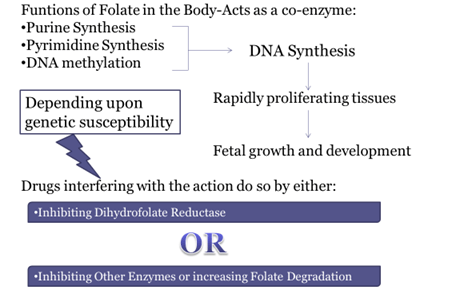
- Neural crest cell disruption
- During embryogenesis the neural crest cells, differentiates into two cell populations:
- Cranial Neural Crest cells – structures in the craniofacial region
- Truncal Neural Crest cells – components of the peripheral nervous system
- A variety of molecular signals and receptors are implicated in neural crest cell development:
- Fibroblast growth factors, Integrins, Cadherins, Pax3, Endothelins
- Both excess and deficiency can be teratogenic
- Retinoid teratogenicity is mediated by the retinoic acid receptors,RARs and retinoid X receptors, RXRs.
- Endocrine disruption
- The ability of a hormone or endocrine disrupting chemicals to cause teratogenesis depends upon:
- Protein binding in the mother
- Protein binding in the fetus
- Drug metabolism (Active metabolite), Placental transfer capabilities
- Oxidative stress
- The developing embryo is especially susceptible to high levels of ROS because of its weak antioxidant defense, in particular in the early stages of organogenesis.
- Vascular disruption and specific receptor
They give rise to structural birth defects.
Disturbances in the blood circulation in:
- Uterine-placental unit (cord obstruction)
- Placental-fetal unit (placental insufficiency)
- The fetus itself (hypoxia, generation of ROS)
Direct effects of vascular disturbances:
- Aberrant differentiation
- Distortion of contiguous tissues
- Loss of tissue
- Incomplete development of structures within the same or a secondary embryonic developmental field
Vasoactive agents acting through this mechanism:
- Misoprostol
- Aspirin
- Ergotamine
- Pseudoephedrine
- Enzyme-mediated teratogenesis
- Cyclooxygenase-1
- Non selective NSAIDS by inhibition of COX 1 may be involved in the induction of cardiac anomalies, orofacial clefts and diaphragm defects.
Teratogenic Drugs – IN FIRST TRIMESTER OF PREGNANCY
- Analgesic, Anticonvulsant, Anticoagulant, Antidepressant, Antithyroid, Vitamin A, Metal toxic, Sedative/ hypnotics, Aminoglycosides
Analgesic (aspirin)
- Gastroschisis
- Decrease prostaglandin à decrease uterine contraction àdelayed onset of labor & prolonged period of pregnancy
- During delivery àsevere bleeding because aspirin decrease platelet aggregation
Anticonvulsant
- Fetal hydantoin syndrome :
- cranio facial malformation:
-Cleft lip and palate, Broad nasal bridge, Ocular hypertelorism, Abnormal ears
- congenital heart disease
- limb malformation
- mental and growth retardation
Anticoagulant ( warfarin & Coumadin )
- Fetal wafarin syndrome:
-Nasal hypoplasia, bone stippling, Bilateral optic atrophy, Mental retardation
- Respiratory distress syndrome
- Fetal and maternal hemorrhage
Antidepressant (imipramine)
- Cleft palate
- Defect in abdomen
- Adrenal hypoplasia
- Cardiovascular defect
Antithyroid ( propylthiouracil & methimazole )
- Fetal goiter
Vitamin A derivatives ( retinoic acid ) à Isotretinoin
- Cranio-facial dysmorphism
- Cleft palate
- Thymic aplasia
- Neural tube defect ( spina bifida cystic )
Metal toxic (lithium)
- Hypotonia
- Cyanosis
- Lethargy
- Poor respiratory
Sedative / hypnotics (diazepam )
- Cleft lip and palate
- Inguinal hernia
- Congenital heart disease
- Pyloric stenosis
- Breathing difficulties
Aminoglycosides (streptomycin & Kanamycin )
- Congenital deafness
- Ototoxicity
TERATOGENIC DRUGS IN SECOND TRIMESTER OF PREGNANCY
ACE INHIBITOR
- MECHANISM OF ACTIONS
- Produce vasodilatation by inhibiting formation of angiotensin II and breakdown bradykinin
- Mixed vasodilator
- In cases of heart failure, cardiac output is maintained / even increase
- Increase renal blood flow BUT decrease glomerular filtration rate à decrease glomerular hypertension
- IF USED IN 2ND – 3RD TRIMESTER OF PREGNANCY
- fetal hypotension, renal failure, oligohydramnios, death
DIAZEPAM
- Centrally acting spasmolytic drug
- It facilitates action of GABA in CNS
- It acts as GABA synapse and produce sedation at doses required to reduce muscles tone
- RISKS OF…
1) cleft palate
2) cardiac and circulatory defects
TERATOGENIC DRUGS IN THIRD TRIMESTER OF PREGNANCY
Tetracycline, ACE inhibitors, chloramphenicol, aminoglycosides, sulfamethoxazole, trimethoprim
TETRACYCLINE
- Protein synthesis inhibitor à by binding to the 30S ribosomal subunit in mRNA translation complex
- IN PREGNANCY àdental discoloration in children, maternal hepatotoxicity with large parenteral doses
CHLORAMPHENICOL
- Bacteriostatic drug that stop bacterial growth by inhibiting protein synthesis
- Prevent protein chain elongation by inhibiting peptidyl transferase activity of bacterial chromosome
- Intravenous chloramphenicol use has been associated with Gray Baby syndrome
- This occur in newborn infants because they liver enzymes not yet fully developed à chloramphenicol remains unmetabolised in body
- Manifest as – hypotension and cyanosis
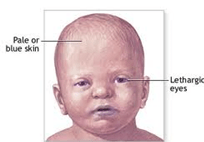
AMINOGLYCOSIDES
- EG: GENTAMICIN, STREPTOMYCIN
- They interfere with the proof-reading process à increased rate of error in synthesis with premature termination
- Inhibition of ribosomal translocation
- Disrupt the integrity of the bacterial cell membrane
- They may cause auditory or vestibular nerve damage
SULFAMETHOXAZOLE, TRIMETHOPRIM
- Sulfonamide bacteriostatic antibiotic
- Structural analogs and competitive antagonist of PABA
- Inhibit normal bacterial utilization of PABA for the synthesis of folic acid
- Used as a bacteriostatic antibiotic in prophylaxis and treatment of urinary tract infections
- Trimethoprim binds to dihydrofolate reductase and inhibit reduction of DHF to THF
- Sulfamethoxazole inhibit dihydrofolate synthetase
- Neonatal haemolysis
- Methaemoglobinaemia
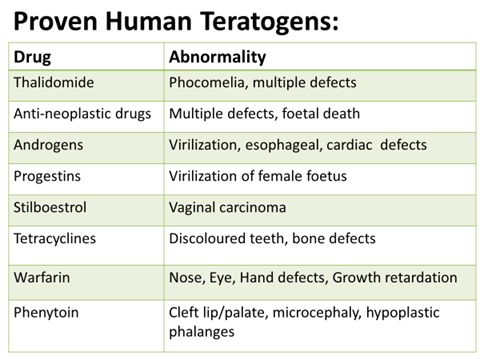
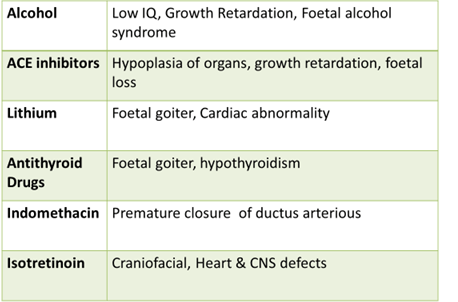
Teratogenicity Test:
- Studies are carried in two animal species (rats & rabbits)
- Drug is given after mating, during the period of organogenesis
- Foetus is then examined for visceral or skeletal abnormalities
